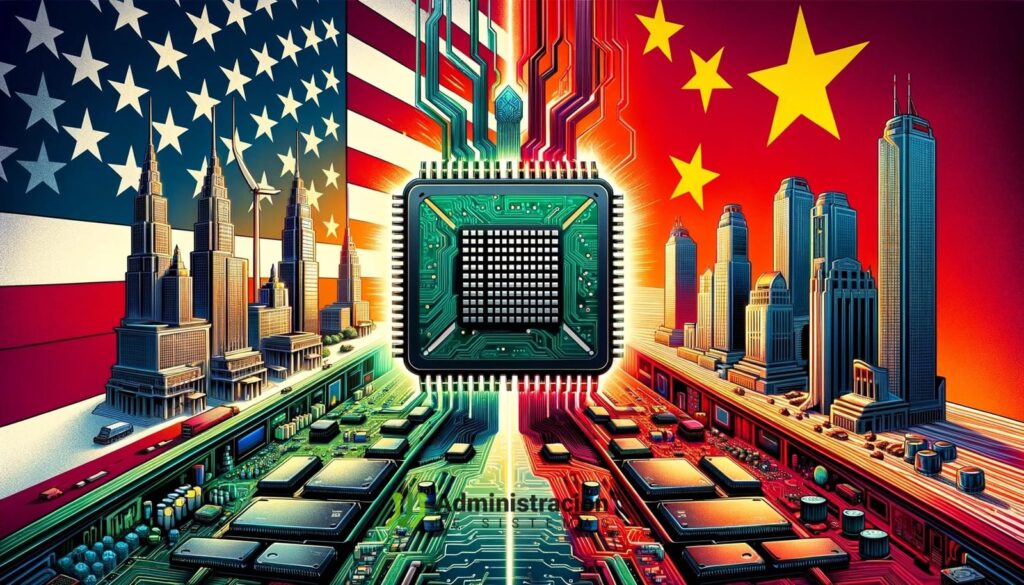The strategic rivalry between the United States and China has found one of its most critical battlefields in the world of semiconductors. These tiny chips, fundamental to everything from artificial intelligence to defense systems, are now at the heart of a global contest for technological supremacy.
🇺🇸 United States: Public Investment Meets Private Innovation
- In 2022, the Biden administration passed the CHIPS and Science Act, allocating $52.7 billion to boost domestic semiconductor manufacturing and R&D. The goal is clear: reduce dependence on Asian foundries, especially TSMC in Taiwan, and re-shore critical chip production.
- Key initiatives such as the National Semiconductor Technology Center (NSTC) in Albany, New York, are expected to serve as pillars of U.S. innovation. This R&D hub includes next-generation EUV (extreme ultraviolet) lithography machines, currently dominated by ASML.
- Analysts estimate that between federal funds, state incentives, and private capital, the U.S. could see up to $1 trillion invested in semiconductor infrastructure by 2030.
🇨🇳 China: Massive State Investment Amid Fragmentation
- In response, China has accelerated its own push for chip sovereignty. In 2024, Beijing launched the third phase of its Big Fund (国家集成电路产业投资基金), channeling nearly $47 billion to support national champions like SMIC, YMTC, and AI chipmaker Biren Technology.
- Despite these massive investments, China’s semiconductor industry remains fragmented and uneven. Attempts to consolidate regional initiatives under centralized state control have faced resistance and inefficiencies.
- U.S. export controls on advanced chip manufacturing equipment have further complicated China’s ambitions, limiting access to tools such as ASML’s EUV systems and high-end NVIDIA GPUs.
📊 Comparative Overview
| Factor | United States | China |
|---|---|---|
| Public subsidies | ~$52.7 billion (CHIPS Act) | ~$47 billion (Big Fund III) |
| Industrial cohesion | High (public-private partnerships) | Low (fragmented ecosystem) |
| Strategic R&D hubs | NSTC (Albany, NY), Arizona, Ohio | Dozens of regional projects |
| Key beneficiaries | Intel, TSMC (Arizona), Micron | SMIC, YMTC, CXMT, Biren Tech |
| Political friction risks | Budget disputes, electoral cycles | Bureaucratic inefficiency, overreach |
🌍 Global Implications: A Fragmented Digital Future
- The semiconductor race reflects a broader techno-geopolitical realignment. As both countries strive for self-sufficiency, global supply chains are being reconfigured.
- Emerging players like India, Vietnam, Mexico, and Eastern Europe are positioning themselves as new hubs for chip assembly, packaging, or testing.
- However, lack of coordination across nations raises risks of overcapacity, duplicated investments, and long-term inefficiencies.
🧭 Strategic and Political Outlook
- Former President Donald Trump has publicly opposed the CHIPS Act, criticizing it as “corporate welfare” and calling instead for higher tariffs on Chinese imports. This reflects an ideological divide over how to achieve economic resilience.
- Meanwhile, bipartisan consensus in Congress maintains that securing chip independence is a national security priority that transcends party lines.
- China, for its part, continues to view semiconductors as a cornerstone of its “dual circulation” strategy, aiming to bolster domestic demand while minimizing external vulnerabilities.
✅ Conclusion
The U.S.-China chip rivalry is about far more than just silicon. It’s a clash over who will write the rules of tomorrow’s technological landscape. As both superpowers pump billions into infrastructure, R&D, and workforce development, the global chip industry is being reshaped at breakneck speed. Whether this race results in innovation or isolation remains one of the defining questions of the decade.

